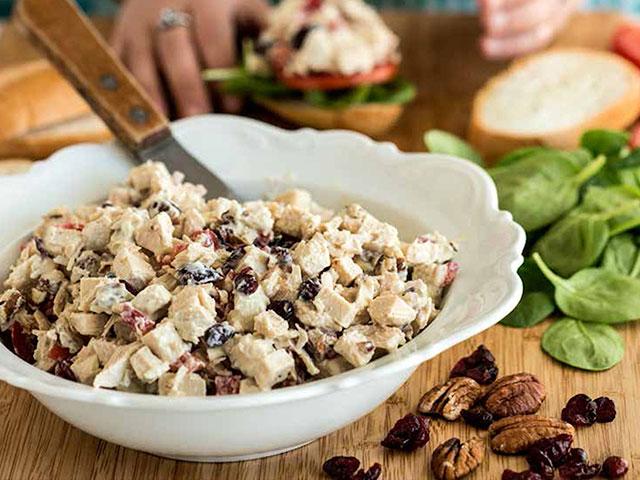Seven Absolutes of Healthy Eating
Eating...something so basic and fundamental, it wouldn't seem that it need be so complex. Yet that's what it has become, and it's no surprise with diet books coming out and topping the bestseller list every few months often contradicting one another that we find ourselves in our current state.
With 65 percent of all Americans battling the bulge and more confused than ever, who do you listen to and who can you trust? In this article, you'll walk away with seven absolutes that will help you lay a solid foundation of healthy eating without having to ever second guess it.
1. Eating Out
This is something more and more Americans are doing on a daily basis. While diet books have sold millions of copies advocating the reduction or all-out elimination of fats and later carbohydrates, they've overlooked one of the two true culprits that have led us to our current state. The first was the shift from more labor intensive jobs like farming and factory work to more sedentary technology based jobs. Even our entertainment is more sedentary. The other is eating out.
In fact, by the restaurant industry's own numbers in 1970, they were a $40-billion-a-year industry. However, fast forward 30 years, and in 2000 they had grown more than ten-fold to $440 billion, with serving sizes skyrocketing up to five times their original sizes. During these same 30 years, our waistlines had no choice but to follow suit, and they certainly did. On any given day in this country, 50-60 percent of all meals are eaten outside the home.
- To regain control, start shopping and preparing your own meals. You'll almost always be better off and you will save money.
- If you have to eat out, log it on your calendar so you will be aware just how often it's happening.
- Learn your portion sizes and stick with them. For example, a serving of pasta is about what you can fit into the cup of your hand—not the gigantic plateful when you eat out, literally two days worth of grains! People blame carbs when it was really the amount eaten.
- Pass on the calorie-dense bread and chips and request a house salad (not Caesar) or broth-based soup be brought out right away instead.
- Share your entrée or tell the waiter to box half of it up before bringing your meal out.
2. Be label savvy
Many people never bother to look on the back of the package to see the food's nutritional content. It seems too complicated, and who could blame them? It's unfortunate because often right next to your favorite foods are the healthier versions that taste just as great. I love chocolate chip cookies and would try to restrain myself to eating just the three that made up one serving, until I found chocolate chip teddy grahams where a serving is like 14 smaller pieces. This is more satisfying, as it provides more hand to mouth and more crunching than my usual paltry three cookies and is much lower in saturated fat and sugars. If I didn't read the label, I would have never been able to make that choice.
So here are the five main things you should look for on a nutrition label:
- Serving sizes and calories per serving. This is probably the biggest thing to look out for. Often manufacturers will break up what a serving is to make the label not look so outrageous. For example, I picked up one of those noodle packets every college student lives on, and to my dismay, it said “serving size 1/3 packet”. No one opens up that single serving packaging, breaks off one third dry noodles, and puts the rest back. Plus, there is only one spice packet. They do this because the sodium content would read 2,100 mg instead of the 700 mg you see on the label. The cutoff for sodium per day is 1,500 mg. This one packet contains more than your whole day's worth. Always look for the servings per container and multiply everything else by that number.
- Saturated fat. Compare other brands and pick the one that's lowest, or better yet, that doesn't contain this artery clogging fat.
- Sodium. Your daily limit is 1,500 mg, so keep this in mind when shopping.
- Fiber. Pick foods that contain fiber instead of others that do not. Men need 38 grams a day, and women need 25 grams. Foods that are higher in fiber also hold off your hunger better. Choose breads that have at least 2 grams of fiber per serving.
- Vitamins and minerals. Read the label to see what vitamins and minerals you'll get out of eating this food, and choose the one that does the most for you.
3. Balanced eating
Low-carb and no-carb diets are finally coming off their highpoint of popularity, but they are still around. Diets are nothing new and have been around since the 1800s, with all of them suffering a failure rate of 95-98 percent within six months.
While balanced eating can mean different things to different people, the point is we were given these macronutrients (proteins, carbs, and fats) for a reason. No one food group should ever be vilified; what is most important and has been said time and time again by every major health organization is the total amount of calories eaten. (See The Final Makeover for exact formulas.) It's this universal law of energy taken in versus energy expended that determines whether we gain fat, lose fat, or maintain balance. Don't fall for all the gimmicks.
4. Eating every three hours
Now that you understand no food groups are off limits or are the sole reason for your struggle with fat, we come to how often we should eat. The best way to explain this is to think of a fireplace in your home. Each day you have a stack of wood you need to burn, otherwise it accumulates and carries over to the next day. When people skip breakfast, it's like you don't start that fire until 12 noon. You missed out on a lot of wood burning hours. Also when you go more than three hours without having nourishment, your body's metabolism goes into conservation mode and slows down. Think of that fire burning out without any more wood for fuel. The goal is to keep your metabolism fired up all day burning calories and providing you with energy to do your activities and concentrate.
People erroneously believe if they don't eat they will lose fat. Wrong. What happens is your body thinks you're in the jungle starving and will slow everything down to conserve. Often, if this continues, your body will cannibalize your lean muscle tissue to get the fuel your body, particularly your brain, needs. Your muscle is a much more readily available fuel source than fat, and your body will go to it first. So your scale drops, but you stay flabby and your metabolism drops even further. You finally eat again and the weight comes back with some friends, and this frustrating cycle continues.
Work with your body and fuel it instead of against it. Example: Eat your breakfast. Then two or three hours later, have a snack like yogurt or a piece of fruit. Continue on your day, letting no more than three hours go by without eating.
5. Drinking on the pounds
The fluids you drink often mean the difference between gaining fat or losing it. People usually don't think about the calorie content of drinks. This is a big mistake, as the calories very quickly add up, especially from multiple drinks. Think about how many sodas someone might have in a day. Each can carries with it 140 calories, with the Gulp size canisters giving around 600 calories, or 1/2 to 1/3 of an average woman's entire day's calories.
Same goes for coffee drinks at your favorite corner stop. On the low end, with non-fat everything and no whip cream, you're looking at 160 calories—upwards to 500 calories on the dessert coffees. Some people will have a few of those a day, hardly eat, and wonder why they cannot drop the fat. This doesn't mean your favorite coffee is off limits, but you need to choose wisely and factor them into your entire day. Being aware of what you're drinking is the first step.
6. Water intake
Speaking of drinking, this is a perfect alternative to high-calorie drinks. Save the calories and actually eat the food. If water seems too dull for you, there are some great 0-calorie flavored waters out now. So how much water do you need a day? Here is a quick way to find your personal number. Take your weight and divide it by two. That's how many ounces you need to get a day. People have heard this for so long but still overlook its importance. Maybe this will help put it in perspective:
- Your brain is 78 percent water. [McIlwain, H. andBachelard, H.S., Biochemistry and the Central NervousSystem, Edinburgh: Churchill Livingstone, 1985.]
- Your blood is 84 percent water. [UC Berkeley Wellness Foods A toZ, Rebus, Inc. New York, NY.]
- Your muscles are 76 percent water. [[ibid]]
- Even your bones are 22 percent water. [[ibid]]
Makes more sense now why water is so important. Our bodies lose 64-96 ounces each and every day through sweating, breathing, urinating, and even sneezing. When we are physically active, we need to replace even more. Yes, you can get it from other sources, even some of your foods—this is why thirst is sometimes miscued as hunger—but nothing is better and easier on your body than pure water.
7. Healthy not “skinny”
This is a subject that's close to my heart. For far too long we've judged by the outward appearance. If someone was skinny, they were healthy and in good shape, if they were larger, they must be lazy or eat all the time. My favorite verse, 1 Samuel 16:7, speaks directly on this: “The Lord doesn't see as man sees, man looks on the outward appearance, but the Lord looks on the heart.”
You see, the outside doesn't always tell you the whole story. I can't tell you how many “skinny” models or actresses I've worked with that when we do a body fat test, they are in the 38-percent range, classifying them as—get this—obese. On the contrary, I have larger clients that are active and fit that are in the 28-percent range, which is normal. Yet, if you judged by outward appearances, you would be completely wrong. The problem is people fall prey to the lie that you have to look a certain way to be fit and healthy. If they cannot attain the false standard, then they give up or never embark on the journey of health and wellness.
We as believers should know better about judging by outward appearances. Our reasons for becoming active and fit should be to be set apart from the culture, not to chase after it's unrealistic standards of beauty that don't exist. We are followers of Christ, and this is an area where we need to lead and stop following. Be encouraged and take this journey one day at a time.






